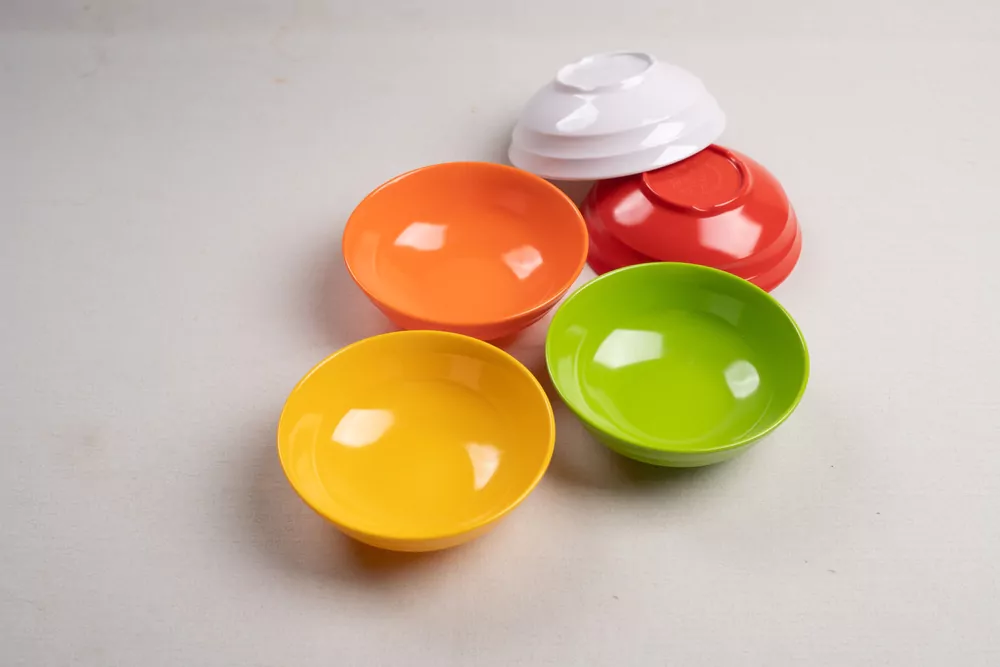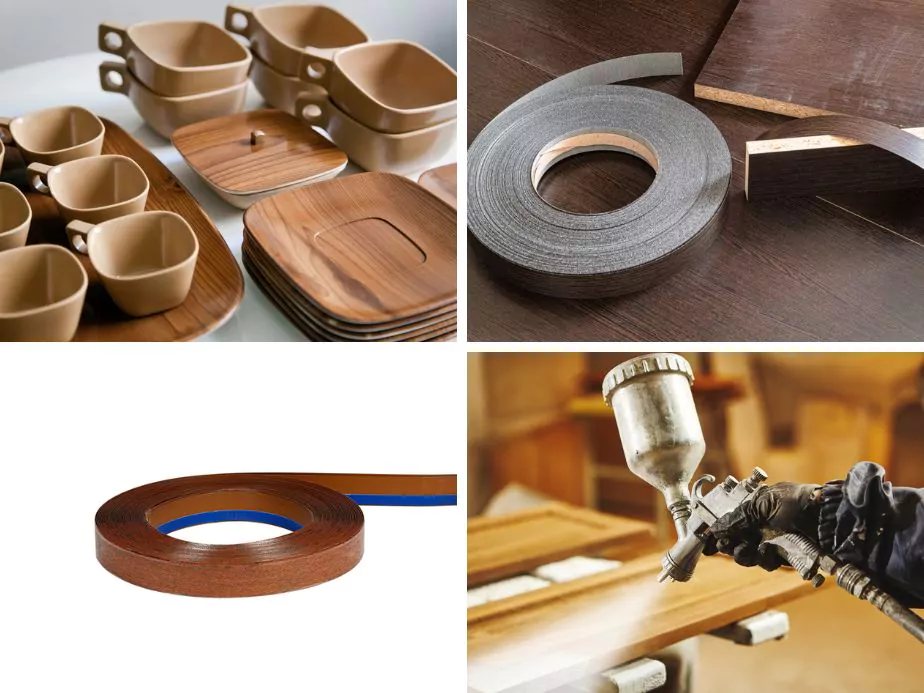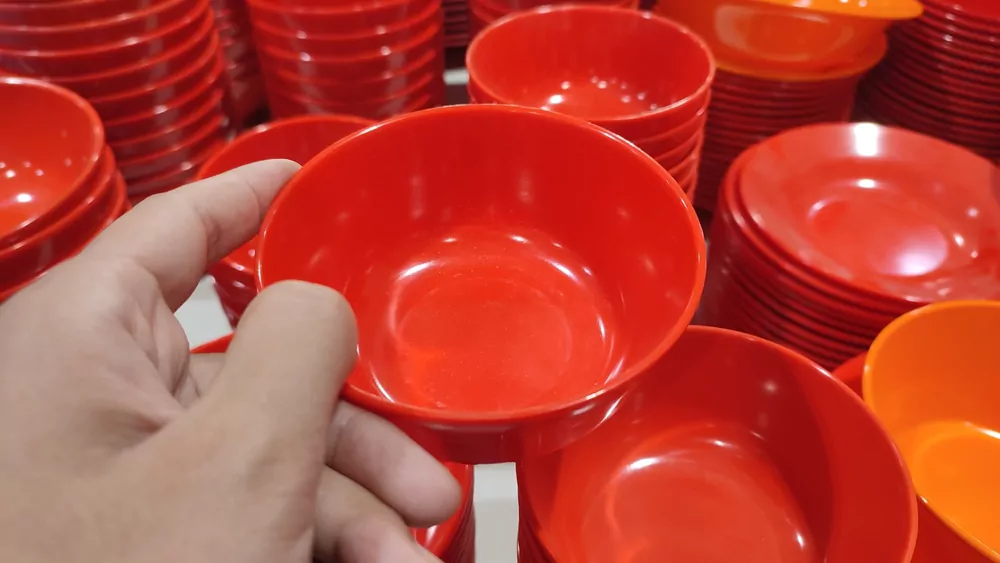What is Melamine Material? – Uses of Melamine and More

Melamine is a versatile material that has gained popularity in recent years due to its unique properties and wide range of applications. From kitchenware to furniture, melamine has proven to be a reliable and cost-effective solution for a variety of needs. In this blog, we will explore what melamine material is, its uses, and whether it is a type of plastic. We will also delve into the world of melamine crockery, discussing its benefits and potential drawbacks. So let’s begin our journey into the fascinating world of melamine!
1 What is Melamine Material?
Melamine is an organic compound, also known as 1,3,5-triazine-2,4,6-triamine, with the chemical formula C3H6N6. It is a white crystalline powder that, when combined with formaldehyde, forms melamine resin, a durable thermosetting plastic. Melamine resin is a hard, thermally stable material that possesses several desirable characteristics, including resistance to heat, moisture, and chemicals. These properties make melamine an ideal material for a variety of applications, ranging from kitchenware to furniture and construction.
2 Is Melamine Plastic?
Melamine resin, the product formed when melamine is combined with formaldehyde, is a type of thermosetting plastic. Unlike thermoplastics, which soften when heated and can be remoulded, thermosetting plastics are set into their final shape during the initial moulding process and cannot be remoulded once set. Melamine’s thermosetting nature makes it highly resistant to heat and chemicals, contributing to its durability and long-lasting performance in various applications.
3 Uses of Melamine

Melamine’s unique properties make it suitable for a wide range of uses. Some of the most common applications include:
Melamine Crockery: Melamine is commonly used to produce tableware, including plates, bowls, cups, and trays. Melamine crockery is lightweight, shatter-resistant, and dishwasher-safe, making it a popular choice for both home and commercial use.
Laminates and Veneers: Melamine’s durability and resistance to moisture make it an ideal material for laminates and veneers used in furniture, countertops, and cabinetry. Melamine-faced boards are made by applying a thin layer of melamine resin to a substrate, such as particleboard or medium-density fiber board (MDF), creating a smooth, easy-to-clean surface that resists wear and staining.
Insulation: Melamine foam is a lightweight, high-performance insulating material that can be used in various applications, including building insulation, acoustic insulation, and thermal insulation for pipes and ducts.
Adhesives: Melamine-based adhesives are used in the production of wood products, such as particleboard and MDF, offering excellent bonding strength and resistance to moisture.
Flame Retardants: Melamine’s nitrogen content makes it an effective flame retardant. It is often used in combination with other flame retardants to improve their performance.
4 Melamine Uses in Crockery
Melamine crockery has become increasingly popular in recent years due to its many advantages over traditional ceramic or glass tableware. Some of the key benefits of melamine crockery include:
Durability: Melamine is known for its strength and resistance to breakage, making it an ideal choice for households with children or for use in commercial settings where accidents are more likely to occur.
Lightweight: Melamine tableware is significantly lighter than its ceramic or glass counterparts, making it easier to handle and transport.
Heat Resistance: Melamine crockery can withstand high temperatures, making it suitable for use in the microwave. However, it is essential to note that prolonged exposure to high heat may cause the melamine to warp or become damaged.
Dishwasher Safe: Melamine is resistant to the harsh chemicals found in dishwasher detergents, allowing it to be cleaned in a dishwasher without losing its colour or shine.
Versatility: Melamine crockery is available in a wide range of colours, patterns, and designs, making it easy to find the perfect set to match your décor or personal style.
Cost-Effective: Melamine tableware is typically more affordable than ceramic or glass alternatives, making it an attractive option for those on a budget or seeking to outfit a large commercial space.
5 Potential Drawbacks of Melamine Crockery
While melamine crockery offers many benefits, it is crucial to be aware of some potential drawbacks:
Melamine-Formaldehyde Concerns: As mentioned earlier, melamine resin is formed by combining melamine with formaldehyde. Some studies have suggested that melamine may leach trace amounts of formaldehyde when exposed to high temperatures or acidic foods. However, the FDA has deemed melamine tableware safe for use when used according to the manufacturer’s guidelines.
Not Oven-Safe: Melamine’s heat resistance has its limits. It is not suitable for use in conventional ovens or under direct heat, as it may become damaged or release harmful fumes.
Potential for Scratching: Although melamine is durable, it can be susceptible to scratching, particularly when used with sharp utensils. To maintain the appearance of your melamine crockery, it is recommended to use non-abrasive utensils and avoid cutting directly on the surface.
Environmental Impact: Melamine is not biodegradable, and its production process can generate waste and emissions. Efforts are being made to develop more environmentally friendly alternatives, such as bio-based melamine, which is derived from renewable resources.
6 Tips for Choosing and Caring for Melamine Crockery

To ensure you get the most out of your melamine tableware, consider the following tips:
Choose Quality Products: Not all melamine crockery is created equal. Look for products that are BPA-free and meet FDA guidelines for food safety. Investing in high-quality melamine will help ensure your tableware lasts longer and maintains its appearance.
Follow Manufacturer Guidelines: To ensure the safety and longevity of your melamine crockery, always follow the manufacturer’s guidelines for use and care. This includes adhering to recommended temperature limits and avoiding the use of abrasive cleaners or utensils.
Store Properly: When not in use, store your melamine tableware in a cool, dry place away from direct sunlight to prevent warping or discolouration.
Dispose of it Responsibly: If your melamine crockery becomes damaged or reaches the end of its lifespan, dispose of it responsibly. Contact your local waste management facility to inquire about recycling options for melamine products.
7 Wrapping Up
Melamine is a versatile and durable material with a wide range of applications, from kitchenware to construction. Its unique properties, such as heat and moisture resistance, make it an attractive choice for various uses, including melamine crockery. While there are some potential drawbacks to using melamine, such as concerns about formaldehyde and its environmental impact, choosing high-quality products and following proper care guidelines can help mitigate these risks.
By understanding the properties and applications of melamine, as well as its potential drawbacks, you can make an informed decision about whether melamine is the right choice for your needs. Whether you’re looking for durable tableware for your home or seeking a cost-effective solution for your business, melamine offers numerous benefits that make it a popular choice across various industries.
Community Q&A
About This Article
This article has been viewed 863 times.



